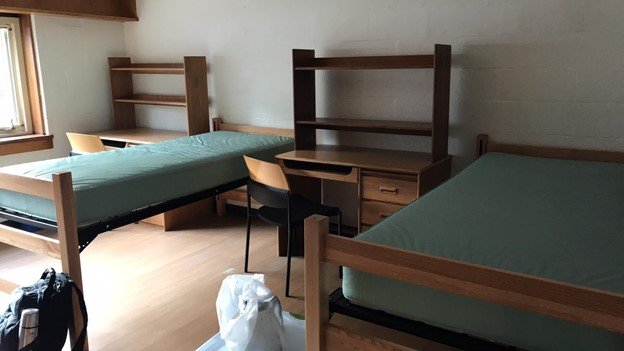Wellesley Dorms: What They’re Like from a Current Student
If you’ve ever been to campus, falling in love with Wellesley is as easy as 1-2-3! With 500 acres of rolling meadows, the eternally gorgeous Lake Waban, and exquisite architecture dating back to the 1920s, Wellesley students are surrounded by natural beauty through all four seasons. This also includes our dorms, which often feature on postcards and are considered home by 98% of our students every year. In this post, we’ll take a tour through the campus dorms and discuss what living at Wellesley is like. All first-year and transfer students are required to live on campus for their first year, but most of us stay on for all four years as real estate in the nearby town of Wellesley is quite expensive. However, we do have an hourly shuttle that takes us to Cambridge, so some students choose to live off campus in Cambridge or Boston, where housing and food expenses can be cheaper than living in our dorms. The main disadvantages would be commute time (~40 minutes with no traffic) and lack of community. Campus is divided into East Side and West Side, and we have three main dorm complexes where students of all class years live together: East Side, Tower Court, and the Quint. Singles, doubles, triples, and the occasional suite/apartment are available during room selection every year, with juniors and seniors usually able to acquire singles. All dorm rooms come with a bookcase, desk, chair, overhead light, dresser, mirror, extra-long twin bed, and mattress. Outside of our major dorm complexes, we also have a few smaller halls on East Side, along with Casa Cervantes and French House (a little farther off campus) for students who wish to immerse themselves in Spanish and French respectively. Other language corridors are available by application in our dorm complexes, including communities for Korean, Arabic, Italian, and many more. Additionally, students may apply for the two co-ops with houses of their own on East Side: a sustainability co-op called SCoop, whose 14 members do not need to pay for the meal plan, and a feminist co-op called Instead, capped at 6 members. Otherwise, living on campus costs the same for everyone: room and board plus the required meal plan total $17,772 for the 2020-21 school year. The major dorm complex on East Side consists of the McAfee, Bates, and Freeman Halls, all connected to one another but each with its own unique community, House President, and team of RAs. Also known as the “new dorms” because they were built most recently in the 1950s, their kitchens — generally one on each floor — were newly renovated last year. There are also communal bathrooms on each floor, and laundry units are generally spaced out every two floors. Bates Dining Hall is also right downstairs, featuring international style menus, a panini press, and an impressive salad bar. Other halls on East Side include Dower, a small dorm next to the main complex, and Stone-Davis, a larger complex by the Chapel. Stone-D has its own dining hall famous for comfort food, and it’s also open for late-night hours (8-10 PM), though closed on Friday evenings and weekends. Homestead (the home of SCoop) and Instead are also located on East Side, along with the Wellesley College Club, Chapel, Weaver House (Office of Admissions), Health Services, the Stone Center Counseling Service, and the Science Center. Accordingly, many STEM majors reside on East Side as these dorms are closest to the Science Center, and also closest to the Ville, the charming (though expensive) few blocks of the town of Wellesley right outside of our campus with various shops, restaurants, and a T station for traveling to Boston. East Side rooms are also the largest on campus! Here’s a picture of just half of my double in Freeman during first year — the half not pictured includes huge closets, a chest of drawers for each person, two mirrors, and some more spacious windows. Tower Court is the postcard dorm complex, sitting up on the huge hill overlooking our largest lawn — Severance Green — which is great for both picnics and sledding, depending on the season. Also known as West Side, this complex includes Tower East, Tower West, Severance Hall, Claflin Hall, and Lake House, all overlooking the beautiful Lake Waban with its picturesque sunsets and swans. These are the oldest dorms, which means that they are also the most prone to burning down in case of a fire and that the elevators are a little sketchy at times, but rooms with a lake view are in high demand, and Tower Great Hall is often said to resemble Hogwarts. Tower and Severance are directly connected; the other two dorms can be reached through underground tunnels, which are generally discouraged for use by the college administration but nonetheless… Tower Dining Hall is nut-free, with a special food station called “Clarity” that offers homecooked-style meals free of the eight major allergens. Laundry machines in Tower Court dorms are located in the basement, and there are communal bathrooms and kitchens on every floor. The exception is Lake House, whose communal kitchen on the first floor is the most spacious and impressive of any dorm on campus. Claflin Hall is also home to Claflin Bakery, which produces all the baked goods for dining halls across campus. The Boathouse and Casa Cervantes are also right next to Tower Court. It is the farthest dorm complex from the Science Center but offers easy access to the Academic Quad and the Lulu Chow Wang Campus Center, which is home to the Bae Pao Lu Dining Hall, a cafe called the Emporium, our student co-ops Punch’s Alley (campus pub) and Cafe Hoop (famous for nachos!), and various other conference rooms and event spaces. While Tower is usually referred to as “West Side,” the Quint is also on West Side! It’s the dorm complex closest to Lulu, the Davis Museum, and the Keohane Sports Center, but also not far from the Science Center or Academic Quad. The Quint consists of the Cazenove, Pomeroy, Beebe, and Shafer Halls set up in a rectangular quad-like arrangement on top of another big hill — this one overlooking Lulu — plus the slightly smaller Munger Hall, separate and to their east. Like Tower Court, there are kitchens and communal bathrooms on every floor, and laundry units in the basements. The Quint’s prime location is difficult to beat, and Pomeroy also hosts a vegetarian and kosher dining hall, offering vegan, peanut-free, and gluten-free dishes along with famous Pomchos — i.e. delicious nachos — on Saturday afternoons. Students living in the Quint also frequent Lulu’s Bae Pao Lu Dining Hall, which is popularly regarded as the best dining hall on campus and open to paying visitors, offering fried rice and fried eggs on Saturdays and made-to-order omelettes on Sundays. And, like Stone-D on East Side, Lulu is open 8-10 PM for late-night meals. First-year students can go random or pick roommates, and they are assigned to rooms after the housing selection process for returning students has concluded. This generally occurs in April, with selection priority by seniority, block groups, and then hall renewal. The process has somewhat changed this year due to COVID, but normally, returning students use an online system called StarRez to select roommate groups of 2-5 students or block groups of 5-7 students. Groups are then assigned a time slot to log into StarRez and pick rooms, and residential life staff release floor plans for all dorms ahead of time, along with hosting open house events so that students can see what various dorm rooms look like. Those electing for block housing have the first time slots, choosing from specific sets of rooms across campus. Seniority applies, however, so that all-senior blocks have priority over mixed blocks of seniors and other class years. After block housing is finished, students opting for hall renewal — i.e. to stay in the same dorm for next year — select rooms, again being assigned time slots by seniority. The last time slots are then for general selection, or students who are hoping to move into a different hall, and then first-years are assigned to remaining rooms over the summer. The StarRez system is new, and last year was its first year of implementation at Wellesley, resulting in around 20 unhoused students in fall 2019. Prior to StarRez, we had a lottery system for housing. While I’ve only been through the selection process once so far, I would advise figuring out your roommate situation by February and doing your research as to where you’d like to live. There are plenty of opportunities to visit rooms and poll friends on their experiences, and once you’ve settled on a dorm, it’s best to make a plan with backups in case your top choice room falls through. We don’t really have any “best” or “worst” dorms on campus — it honestly just depends on where you want to live. I’ve personally stayed in doubles in both Freeman Hall and Tower West so far, and overall am quite happy with the living situation on campus. Spaces are clean, services are convenient, and the facilities staff are super helpful and prompt in responding to maintenance requests should you ever need anything. It also helps that campus is enthrallingly beautiful! As long as you love the people that you live with and do your research on which dorm/room situation best suits you, living at Wellesley truly feels like home. To learn more about our campus, I recommend studying this map and also checking out our student photography club, Wellesley Phocus Photography, for glimpses of the natural scenery. Thinking of applying? Check out these blog posts: The Ultimate Guide to Applying to Wellesley How to Write the Wellesley College Essay 2020-2021 FAQs: Applying to a Women’s College If you want to know your chances of getting into Wellesley, check out CollegeVine’s free chancing engine. It’ll let you know how you stack up against other applicants, and it’ll also give you tips for improving your profile. Sign up for your free CollegeVine account to get started!Overview of Wellesley Dorms
Wellesley Dorms: A Closer Look
East Side Dorms

Tower Court/West Side Dorms
The Quint

Housing Selection Process
Wrapping Up: My Dorm Experience at Wellesley

